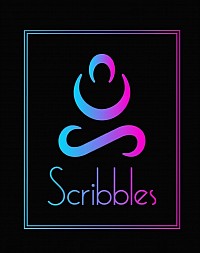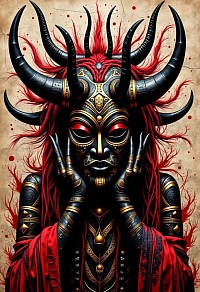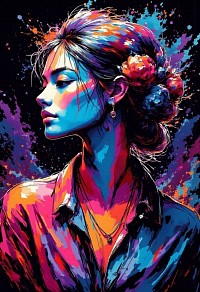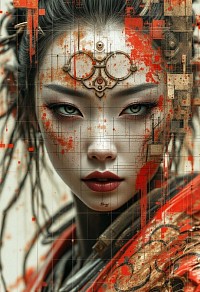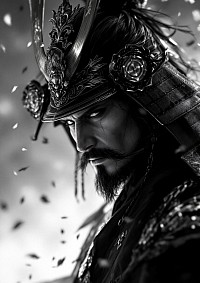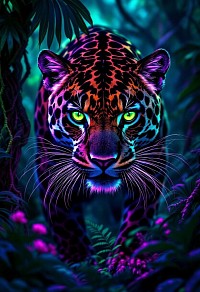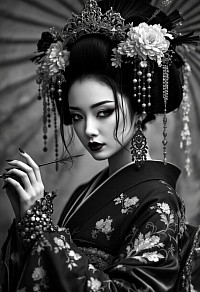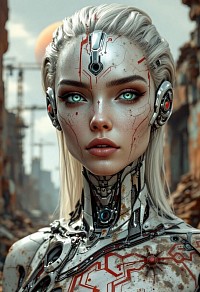Skribbles
Color Spectrums: Painting the Canvas of Art Across Genres
In the kaleidoscopic world of art, color is both a language and a legacy. Artists have long used vibrant spectrums to communicate emotions, tell stories, and push the boundaries of perception. Here's a glimpse into how different art genres uniquely harness the power of the color spectrum to create their signature styles and evoke specific emotions.
1. Impressionism: A Symphony of HuesImpressionists are renowned for their vivid palettes and innovative technique of placing colorful strokes side by side to capture light and movement. This genre flourishes under the warm, sun-kissed hues of a dawn or the cool, shadowy blues of twilight. Artists like Claude Monet and Edgar Degas imbue a sense of immediacy and atmosphere in their work, turning nature into a vibrant tapestry of colors.
2. Fauvism: The Wild Beasts of ColorFauvist artists, aptly named for their ‘wild beasts’ approach, use strikingly bold colors to express artistic rawness and emotional depth. The spectrum here is less about realism and more about conveying intense emotional responses. With Henri Matisse leading the charge, Fauvism celebrates unexpected juxtapositions, merging bright reds with cool greens, and rich purples with electric yellows to create expressive, dynamic compositions.
3. Expressionism: Inner Turmoil on CanvasThe Expressionist movement thrived on unconventional color spectrums, often utilizing intense, dissonant hues to evoke psychological themes and convey the artist’s internal experience. Moods are rendered with deep blues, fiery reds, and somber blacks, channeling the angst and emotions of the modern world. This genre transforms color into a powerful vehicle for introspection and commentary.
4. Minimalism: The Power of SimplicityIn stark contrast, Minimalism employs a more restrained color palette, often focusing on monochromatic tones or simple, primary colors. This genre emphasizes spatial harmony and purity, using color sparingly to highlight form and function. Artists like Donald Judd and Agnes Martin draw viewers into a world of simplicity, where less is profoundly more.
5. Contemporary Street Art: Urban Chromatic RevolutionThe burst of color across urban landscapes makes street art an ever-evolving spectrum of creativity. Graffiti artists like Banksy and Shephard Fairey use vivid, contrasting colors to make bold political and social statements. Whether it’s a vibrant mural stretching across a city block or a striking, detailed piece on a hidden alley wall, the spectrum here is as diverse and dynamic as the urban environment itself.
6. Digital Art: The Infinite PaletteToday, digital artists wield an almost limitless color spectrum, thanks to digital technology that allows them to experiment with infinite shades and hues. This genre merges art with technology, offering a seamless blend of tradition and innovation. Digital tools enable artists to explore the far reaches of imagination, creating experiences that interact with the viewer in real-time.In conclusion, the color spectrums used across different art genres not only define their aesthetic but also their unique emotional narratives. Each brushstroke, pixel, or spray of paint is a testament to the versatility and power of color, proving that the palette is as vital as the medium itself in the world of art.
Whether through the warm glow of Impressionism or the bold statements of Fauvism, color continues to be the ever-thriving heart of artistic expression
The Paradox of Posthumous Fame: Artists Celebrated After Death.
The art world is filled with stories of creators whose brilliance went unrecognized during their lifetimes. Many artists struggled in obscurity, facing rejection and financial hardship, only to have their work embraced and celebrated after their demise. Below are some of the most notable artists who achieved fame posthumously.
1. Vincent van Gogh (1853–1890) Vincent van Gogh is perhaps the most famous example of an artist whose genius was acknowledged only after his passing. During his lifetime, Van Gogh sold only a handful of paintings and was largely deemed a madman. Despite producing more than 2,000 artworks, including famous pieces like "Starry Night" and "Sunflowers," recognition eluded him. It wasn’t until the early 20th century, driven by exhibitions organized by his sister-in-law, Johanna van Gogh-Bonger, that his work gained significant attention. Today, Van Gogh is celebrated as a pioneer of Post-Impressionism and one of the most influential figures in Western art history.
2. Emily Dickinson (1830–1886) Though not a traditional visual artist, poet Emily Dickinson's work provides a fascinating parallel in the literary world. During her life, she was virtually unknown, with fewer than a dozen of her 1,800 poems published—often heavily edited. Only after her death did her sister, Lavinia, discover her cache of poems, leading to the publication of her complete works. Dickinson's innovative use of form and syntax later earned her a place as one of America’s greatest and most original poets.
3. Franz Kafka (1883–1924) Czech writer Franz Kafka, known for his complex and surreal narratives, could not have predicted the immense influence his work would have on literature. Kafka instructed his friend Max Brod to destroy his manuscripts upon his death; fortunately, Brod ignored this request, realizing the value in Kafka's work. The posthumous publication of major works like "The Trial," "The Castle," and "The Metamorphosis" secured Kafka’s legacy as a seminal figure in 20th-century literature.
4. Henry Darger (1892–1973) The art of Henry Darger was a discovery that took the art world by surprise. Known during his lifetime as a reclusive janitor, Darger created a vast and imaginative body of work, including a 15,000-page typewritten fantasy manuscript and extensive watercolor paintings. Unearthed only after his death, his work captivated audiences and scholars alike, and he is now considered an important figure in Outsider Art.
5. Jean-Michel Basquiat (1960–1988) While Jean-Michel Basquiat did achieve a degree of fame in his short life, it was after his untimely death at the age of 27 that his work began to be fully recognized and celebrated. Initially known for his street art under the pseudonym SAMO, Basquiat's neo-expressionist work explored themes of race, identity, and power. Today, he is hailed as one of the leading artists of his generation, with his pieces fetching record prices at auctions.
6. Modigliani (1884–1920) Amedeo Modigliani, the Italian painter and sculptor, is celebrated for his unique style characterized by elongated faces and figures. Despite his prolific output, Modigliani’s work found little success during his lifetime, leading to financial struggles. However, his posthumous fame is substantial, with his works now highly prized by collectors and institutions worldwide.
The stories of these artists remind us that recognition and acclaim can be a matter of timing as much as talent. Their journeys highlight the complex relationship between an artist's life and the legacy they leave behind, proving that true artistry can transcend the limitations of its own era.
Success in the Blockchain: The Artist's New Frontier
In a world where technology and creativity increasingly intersect, the blockchain emerges as a powerful ally for artists seeking new ways to showcase their talents and engage with audiences. Far from being just a tech buzzword, the blockchain offers artists unprecedented opportunities for success, transforming how they present their work, interact with fans, and participate in myriad creative projects.
A New Canvas for Creativity
Blockchain technology is revolutionizing the art world, offering artists unique platforms for innovation and collaboration. Non-fungible tokens (NFTs), for instance, have become a popular medium for artists to digitize their creations, ensuring both provenance and ownership are indisputable aspects of their work. Each NFT is a certified original, allowing artists to maintain creative control while engaging with a global audience.
The Allure of Multiple Collections
Contrary to the notion that releasing several collections might signal an artist spreading themselves too thin, it instead highlights their desirability and versatility. Artists on the blockchain often become sought after, not just for their artistic vision, but for the way they infuse innovation into diverse projects.
Collaborations: A Tool for Visionaries
Artists frequently participate in other creators' projects, acting as vital conduits through which visions are realized. In these collaborations, they bring their unique perspectives and techniques to the table, helping project owners articulate their concepts more vividly. For many artists, the blockchain becomes a fertile ground for such dynamic partnerships, offering a seamless blend of artistry and technological prowess.
Empowered and Enabled
One significant advantage of artists working within the blockchain is empowerment. By leveraging smart contracts, artists can ensure they are fairly compensated each time their work is sold or traded. This not only boosts financial security but also drives artists to explore their creativity with renewed passion and confidence.
A Vision for the Future
As blockchain technology continues to evolve, artists are poised to further its influence on the broader creative landscape. They stand at the forefront of a digital renaissance, wielding blockchain tools to redefine art's role in society. This technology is not merely a new way to sell art; it is a gateway to transforming how art is experienced, shared, and celebrated across the globe.
In conclusion, the success an artist can achieve within the blockchain framework is a testament to their adaptability and forward-thinking approach. By embracing technology, pursuing multiple collections, and engaging in collaborative endeavors, artists are not overwhelmed but rather elevated, becoming integral players in a vibrant, evolving tapestry of digital art.
The Evolution of Digital Art: From Pixels to Possibilities
Digital art has transformed from a niche interest to a significant facet of the contemporary art world, reflecting broader cultural shifts and technological advancements. This article explores the evolution of digital art and contemplates what the future may hold for artists working in this dynamic medium.
1. The Early Days: The Charm of Pixel Art
The journey of digital art began in the late 20th century when artists experimented with rudimentary software and limited resolutions. Pixel art emerged as a distinctive form, where every pixel carried weight and meaning. Despite its simplicity, artists harnessed limited resources to create intricate designs and evoke deep nostalgia, especially within the gaming community. This art form highlights the potential of creativity in overcoming constraints, transforming perceived limitations into a celebrated aesthetic.
2. The Arrival of Graphics Tablets: Bridging the Traditional and Digital
The introduction of graphics tablets marked a turning point for digital artists. These tools allowed for more natural brush strokes and greater precision, blurring the line between traditional and digital art. Artists could replicate the feeling of painting or drawing while benefiting from the versatility of digital mediums. This technological advancement democratized artistic expression, making it accessible for both seasoned professionals and emerging talents.
3. The Rise of Online Communities:
Collaboration and Inspiration
As the digital art landscape matured, online platforms emerged as vital spaces for artists to showcase their work, connect, and share insights. Social media and art-focused communities have fostered collaboration and provided opportunities for feedback and inspiration. Artists participate in challenges and themes that encourage creativity and innovation, enabling a global exchange of ideas that enriches the digital art dialogue.
4. From Hobby to Career:
The Influence of NFTs
In recent years, the rise of non-fungible tokens (NFTs) has revolutionized the digital art market, transforming how artists monetize their work. NFTs have opened new avenues for expression and financial sustainability, allowing artists to sell digital creations directly to collectors without intermediaries. This shift has initiated conversations about ownership, value, and the future of artistic creation in a digital economy.
5. Future Trends: Embracing Technology and Innovation
As we look ahead, the future of digital art appears vibrant, with ongoing advancements in augmented reality (AR) and virtual reality (VR). These technologies promise to create immersive experiences that engage viewers in unprecedented ways. Artists may soon find themselves breaking new ground, combining traditional techniques with cutting-edge technology to create multi-dimensional works that challenge our perceptions of art.
Conclusion
The evolution of digital art illustrates a remarkable journey from its humble beginnings to its current status as a respected and influential art form. As technology continues to advance, so too will the opportunities for artists to innovate, collaborate, and express their unique voices. The fusion of creativity and technology will ensure that the future of digital art remains as exciting and transformative as its past.
NFT Trends: What Artists Need to Know
As an NFT artist navigating the vibrant digital landscape, staying updated on current trends is essential for success and visibility. In this article, we’ll explore key NFT trends impacting the art world and how they can benefit creators like you.
1. Emergence of Utility NFTs
While many NFTs are celebrated for their artistic value, a growing trend is the integration of utility. Artists are now creating NFTs that offer additional benefits, such as access to exclusive content, events, or even physical goods. This trend enhances the perceived value of your art, allowing you to engage your audience in innovative ways.
2. Fractional Ownership
Fractional ownership is gaining traction, allowing multiple buyers to own a piece of a high-value NFT. This democratizes art ownership and opens new avenues for revenue. Consider exploring fractional offerings for your most sought-after pieces, enabling a broader audience to participate in your art journey.
3. Eco-friendly Solutions
With growing concerns about the environmental impact of blockchain technology, many artists and platforms are shifting towards eco-friendly solutions. Explore platforms that utilize Proof of Stake (PoS) instead of Proof of Work (PoW) models to mint your art. Highlighting your commitment to sustainability can attract environmentally-conscious collectors.
4. Interactive and Generative
Art As technology evolves, interactive and generative art is becoming more popular within the NFT space. This allows you to create art that not only looks beautiful but also engages viewers in unique ways. Experimenting with animations or dynamic art pieces can set you apart and attract attention.
5. Metaverse Integration
The rise of the metaverse presents exciting possibilities for NFT artists. Virtual galleries and digital exhibitions are becoming mainstream, providing new venues for showcasing your work. Consider how you can present and sell your NFTs within these virtual spaces, expanding your reach to a global audience.
6. Community Engagement is Key
Building a community around your art is more important than ever. Engaging with your audience through social media, Discord channels, or community events fosters loyalty and encourages word-of-mouth promotion. Consider ways to involve your followers in your creative process, such as polls or behind-the-scenes looks at your work.
Conclusion
The NFT landscape is constantly evolving, offering exciting opportunities for artists who are willing to adapt and innovate. By understanding and leveraging these trends, you can not only enhance your visibility but also create meaningful connections with your audience. As you embark on this journey, remember that your unique voice and creative vision are what truly set your art apart.
The Influence of Modern Culture on Art: The Evolution and Impact of AI Art
In the ever-evolving landscape of contemporary art, the emergence of artificial intelligence (AI) as a tool for artistic creation marks a significant cultural shift. This new form of art, often referred to as AI art, exemplifies how modern technology has integrated into traditional art forms, reshaping the boundaries between art and technology, and redefining what it means to create.
Creation of AI Art: A Collaborative Process
AI art is generated through sophisticated algorithms that analyze massive datasets to produce unique visuals, relying heavily on user input to guide the creative process. Unlike traditional mediums, where the artist's hand directly shapes the work, AI art demands a symbiosis between human and machine. The human input governs the themes, styles, and parameters, setting a foundation upon which the AI can build and experiment. This interaction allows for a remarkably diverse range of outputs, manifesting the creator’s vision in unexpected and innovative ways.
Art Form Debates and User Influence
Critics often argue whether AI art qualifies as a legitimate art form due to its reliance on machines. However, the essence of art—expressing and communicating human experience—is still at the core of AI creations. The specific inputs provided by users, including textual prompts, training datasets, and stylistic guidelines, are pivotal in realizing a creative vision. These inputs ensure that AI art remains a reflective expression of human creativity, albeit through a digital and modern lens.
Positive Impacts and Cultural Growth
Despite the controversy surrounding its emergence, AI art has contributed positively to the broader art world. It has democratized art creation, allowing individuals with limited traditional artistic skills to produce compelling works. AI art opens new avenues for experimentation, encouraging artists to explore concepts that might be impossible to execute manually. Furthermore, it enhances accessibility and inclusivity, inviting a more diverse range of contributors into the art world.
AI’s ability to process vast amounts of information quickly enables artists to explore a multitude of styles and influences from across cultures, leading to novel amalgamations of aesthetics. This cross-pollination fosters an enriched artistic community where traditional boundaries are blurred, and new art forms emerge, reflecting the diverse tapestry of modern culture.
Negative Press and Challenges
Despite its contributions, AI art has faced significant scrutiny and controversy. Some critics argue that it devalues traditional craftsmanship and potentially infringes upon copyrights, as AI models often learn from existing artworks. Concerns about originality and authenticity also arise, questioning the true authorship of art generated by complex algorithms. However, these challenges also serve as catalysts for important conversations regarding the evolution of art and intellectual property in the digital age.
Conclusion
As AI art continues to evolve, it challenges and expands our understanding of art itself. While it invites debates concerning authenticity and authorship, it also enriches the cultural landscape, driving innovation and providing new means of expression. Ultimately, AI art represents a fascinating intersection of modern culture and technology, highlighting the dynamic nature of creative expression in the 21st century. This burgeoning field invites us to reconsider the role of technology in shaping the future of art and its enduring capacity to reflect the complexity of human experience.
The Influence of Modern Culture on Art: The Evolution and Impact of AI Art
In the ever-evolving landscape of contemporary art, the emergence of artificial intelligence (AI) as a tool for artistic creation marks a significant cultural shift. This new form of art, often referred to as AI art, exemplifies how modern technology has integrated into traditional art forms, reshaping the boundaries between art and technology, and redefining what it means to create.
Creation of AI Art: A Collaborative Process
AI art is generated through sophisticated algorithms that analyze massive datasets to produce unique visuals, relying heavily on user input to guide the creative process. Unlike traditional mediums, where the artist's hand directly shapes the work, AI art demands a symbiosis between human and machine. The human input governs the themes, styles, and parameters, setting a foundation upon which the AI can build and experiment. This interaction allows for a remarkably diverse range of outputs, manifesting the creator’s vision in unexpected and innovative ways.
Art Form Debates and User Influence
Critics often argue whether AI art qualifies as a legitimate art form due to its reliance on machines. However, the essence of art—expressing and communicating human experience—is still at the core of AI creations. The specific inputs provided by users, including textual prompts, training datasets, and stylistic guidelines, are pivotal in realizing a creative vision. These inputs ensure that AI art remains a reflective expression of human creativity, albeit through a digital and modern lens.
Positive Impacts and Cultural Growth
Despite the controversy surrounding its emergence, AI art has contributed positively to the broader art world. It has democratized art creation, allowing individuals with limited traditional artistic skills to produce compelling works. AI art opens new avenues for experimentation, encouraging artists to explore concepts that might be impossible to execute manually. Furthermore, it enhances accessibility and inclusivity, inviting a more diverse range of contributors into the art world.
AI’s ability to process vast amounts of information quickly enables artists to explore a multitude of styles and influences from across cultures, leading to novel amalgamations of aesthetics. This cross-pollination fosters an enriched artistic community where traditional boundaries are blurred, and new art forms emerge, reflecting the diverse tapestry of modern culture.
Negative Press and Challenges
Despite its contributions, AI art has faced significant scrutiny and controversy. Some critics argue that it devalues traditional craftsmanship and potentially infringes upon copyrights, as AI models often learn from existing artworks. Concerns about originality and authenticity also arise, questioning the true authorship of art generated by complex algorithms. However, these challenges also serve as catalysts for important conversations regarding the evolution of art and intellectual property in the digital age.
Conclusion
As AI art continues to evolve, it challenges and expands our understanding of art itself. While it invites debates concerning authenticity and authorship, it also enriches the cultural landscape, driving innovation and providing new means of expression. Ultimately, AI art represents a fascinating intersection of modern culture and technology, highlighting the dynamic nature of creative expression in the 21st century. This burgeoning field invites us to reconsider the role of technology in shaping the future of art and its enduring capacity to reflect the complexity of human experience.

